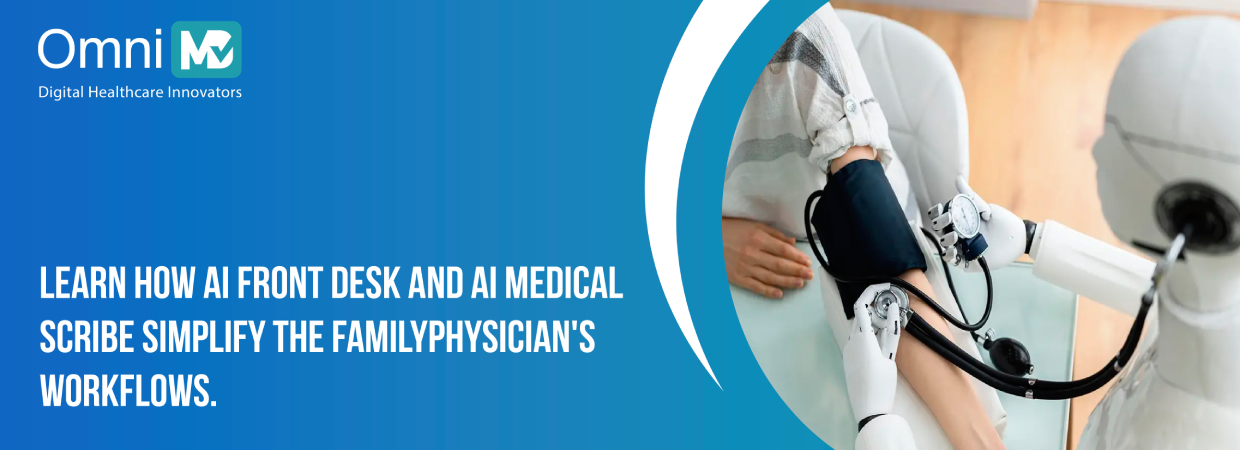The Most Effective Ways to Use AI in Your Family Medicine Practice
Dissimilar to other practices, family medicine takes a person-centered approach, where individuals precede the illness. Considering the social and psychological dimensions of a patient’s life, it is distinctively recognized for treating people with empathy, care, and passion. In family medicine, personal relationships, often spanning years or generations, are not just a by-product but a critical aspect.
In contrast, AI, in its current state, operates largely through pattern recognition and probabilistic models, often divorced from the subjective circumstances of the patient. Yet, its speed, accuracy, and efficiency in diagnosing and supporting clinical decisions have earned it the moniker of the ‘stethoscope of the 21st century’. However, this power must not be mistaken for wisdom. The challenge, then, is not to choose between AI and human care, but to shape a middle path that marries the intelligence of algorithms with the emotional literacy of physicians.
Therefore, the role of AI in family medicine might best be viewed through the lens of the 1997 chess match between Garry Kasparov and IBM’s Deep Blue, a supercomputer. Kasparov, defeated by the machine, later remarked that he might have triumphed if he had access to the same database. That insight bore fruit in 2014, when freestyle matches were organized between AI, humans, and AI-assisted humans. And to a surprise to many, AI-assisted human teams outperformed both solo human and AI players, with 53 wins, compared to 42 by AI alone. The implication is clear: technology becomes transformative not when it replaces human judgment but when it amplifies it.
This blog explores how AI, thoughtfully leveraged, can upgrade family medicine by supporting the long arc of relational care that defines it. Let’s begin.
Integrate AI into Your Family Medicine Office Software
Integrating advanced AI technologies, including predictive analytics, computer vision, and rule-based automation, into the digital infrastructure of family medicine practice marks a significant event in how care is delivered, documented, and optimized.
Within the realm of chronic disease management, a foundational pillar of family medicine, AI enables the extended temporal evaluation of diverse data streams, including wearable outputs, laboratory results, and physician-authored notes. This capacity supports you with evidence-based recommendations for early intervention in complex health conditions such as diabetes, hypertension, and asthma.
Remote patient monitoring (RPM) further augments these capabilities, with AI selectively triaging biometric anomalies, prioritizing high-risk cases, and minimizing unnecessary manual oversight.
Besides, your preventive and population health initiatives also benefit from AI’s integration. Synthesizing demographic data with established clinical guidelines, the enriched technology alerts any overdue screenings, missed immunizations, and unaddressed risk factors.
Further, in behavioral health, closely interlinked with physical well-being in family practice, AI supports symptom tracking, generates automated referrals, and delivers personalized motivational messaging rooted in risk stratification.
Leverage Medical AI Scribe for Better Decision Making
Every patient encounter, whether in family medicine or any other practice, demands accurate and comprehensive notes, covering everything from patient histories and examination findings to medical decisions and follow-up plans.
While traditional methods divide your attention, jotting down notes during the consultation or spending precious after-hours time completing charts, AI scribes transcribe the patient interactions into comprehensive clinical charting in no time.
Contrary to basic transcription systems, AI Medical Scribe leverages advanced mechanisms trained on a wide array of family medicine-specific data to understand the context behind your spoken words.
During a typical acute respiratory compliant visit, for example, where a patient is seen with cough, fever, and shortness of breath, traditional documentation would simply record reported symptoms, and a brief note on lung auscultation. AI scribe, however, processes the symptoms in context, comparing the current presentation with past episodes, recent exposures, or travel history documented in the record. Further, the scribe intelligently highlights risk factors for conditions like pneumonia or influenza and highlight gaps such as missing vaccination records.
It can even prompt guideline-based actions, like recommending a chest X-ray or rapid flu test when clinically indicated, elevating documentation from passive note-taking to an active, decision-support tool.
That said, the AI medical scribe doesn’t just assist in documenting episodic care, it expands its utility across the broad spectrum of family medicine. Take, for instance, the complex documentation involved in pediatric care. You often find yourself keeping track of developmental milestones, vaccinations, and age-specific screenings. With AI assistance, the scribe automatically tracks these milestones, prompts for necessary screenings like the Ages and Stages Questionnaire (ASQ), and even documents growth chart interpretations as they occur.
Moreover, what sets these AI medical scribes apart is their ability to learn and adapt to your unique style. Over time, the AI Agent fine-tunes its understanding of your terminology, documentation flow, and specific clinical preferences, ensuring the notes remain authentic, audit-ready, and compliant with legal standards.
Deploy AI to automate Front Desk tasks
In family medicine, we often deal with high volume, visit types are diverse, and continuity of care is critical. The front desk, operating as the nerve center of your practice, gets overwhelmed with this sheer volume of routine tasks, contributing to burnout, and limiting staff’s capacity to focus on more human-centric coordination roles.
By embedding AI, you can realign front-line workflows into intelligent, responsive, and self-learning systems that can handle dozens of microtasks autonomously, at scale, and with accuracy.
Take appointment scheduling and management, for instance, a core front-desk function that AI can re-engineer at multiple levels. AI agents interfaced with your phone system or website can handle inbound appointment requests conversationally, identify appropriate time slots by parsing visit type, provider availability, and patient preferences, and resolve scheduling conflicts. These systems also handle rescheduling and cancellations, detect patterns in no-show behavior, and suggest scheduling strategies for high-risk or habitually late patients.
Further, at check-in, the AI agents can validate phone numbers, auto-fill data from prior visits, and extract ID or insurance card data using computer vision, all of which previously required manual front-desk oversight
Moreover, with an AI front desk, you can even automate payment collection. AI calculates expected copays or prior balances, displays payment options via kiosks or patient portals, and offers card-on-file functionality or payment plans, freeing your front-desk staff from handling card swipes or cash drawers.
How Does OmniMD Facilitate this Change for You?
Having over 25 years of experience in IT services and software development, with a dedicated team of over 250+ healthcare innovators, OmniMD weaves these AI-driven capabilities directly into your daily workflows, amplifying your human touch with thoughtful, adaptable technology.
At the front desk, we deploy conversational AI interfaces and robotic process automation to handle high-volume and repetitive tasks.
During the patient encounter, our ambient AI Medical Scribe captures the clinical conversation and auto-generates clinical charts customized to your documentation preferences. It draws from a rich library of family medicine-specific terminology, understands context from longitudinal records, and proactively prompts you on gaps in care.
Beyond the visit, our platforms support population health and chronic disease management through predictive analytics and natural language processing (NLP) engines that mine structured and unstructured data across your entire panel.
From identifying uncontrolled hypertensive patients to detecting patterns in asthma exacerbations, we design solutions that continuously evolve to reflect your clinical style, preferences, and workflows.

AI for Family Medicine – Smarter, Faster Care
Save time, ease burnout, and care better.

 Written by Neha Singh
Written by Neha Singh
 Reviewed by Shivani Joshi
Reviewed by Shivani Joshi